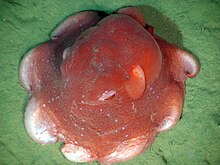Opisthoteuthis californiana
| Flapjack octopus | |
|---|---|

| |
| Scientific classification | |
| Domain: | Eukaryota |
| Kingdom: | Animalia |
| Phylum: | Mollusca |
| Class: | Cephalopoda |
| Order: | Octopoda |
| Family: | Opisthoteuthidae |
| Genus: | Opisthoteuthis |
| Species: | O. californiana
|
| Binomial name | |
| Opisthoteuthis californiana | |
Opisthoteuthis californiana, also known as the flapjack octopus,[3] is a species of umbrella octopus.
Description
The flapjack octopus usually appear dark red.[4] Their maximum size is 20 centimetres (7.9 in) mantle length.[4] They have eight jointed legs which are affixed together in an umbrella shape.[5] They have a gelatinous body, which spreads into a parachute shape when maneuvering through dimly lit water.[5] The flapjack preys on small fishes and planktonic crustaceans.[4] They swim by moving their fins, pulsing their webbed arms, pushing water through their funnel for jet propulsion, or all three at once.[6] Their depth range is: Para-larvae 200 metres (660 ft), adults 500–1,500 metres (1,600–4,900 ft).[4]
Distribution
This species has been reported off Eureka Bar, California, at 350 metres (1,150 ft). It is also known from Japan, off Kashima-Nada, at 530–560 metres (1,740–1,840 ft).[7] Nesis (1982/87) reports it from the Bering Sea to the Sea of Okhotsk to off central Honshū.
Classification
The Opisthoteuthis californiana is one of 14 species in the genus Opisthoteuthis. These species are also collectively known as the flapjack devilfishes.[8]
Species of Opisthoteuthis are the most compressed, in the anterior-posterior axis, of any cephalopod. This flattened appearance gives them the common name of flapjack or pancake devilfish. Species are thought to be primarily benthic although they are capable of swimming and in some species the swimming may be an important component of their pouncing on minute prey. As in other cirrates, most species are poorly known.
Popular culture
ChuChu from Kirby's Dream Land 3 is a flapjack octopus. In Finding Nemo, one of Nemo's classmates, Pearl, is a flapjack octopus.[9] Lenny the flapjack octopus is the main character in a children's book The Adventures of a Flapjack Octopus.[10]
References
- ^ Lyons, G.; Allcock, L. (2014). "Opisthoteuthis californiana". The IUCN Red List of Threatened Species. 2014: e.T163065A968048. doi:10.2305/IUCN.UK.2014-3.RLTS.T163065A968048.en. Downloaded on 07 February 2018.
- ^ Philippe Bouchet (2018). "Opisthoteuthis californiana Berry, 1949". World Register of Marine Species. Flanders Marine Institute. Retrieved 7 February 2018.
- ^ "Steller Sea Lion and Northern Fur Seal Research: Environmental Impact Statement". 22 November 2017. Retrieved 22 November 2017 – via Google Books.
- ^ a b c d Jorgensen, Elaina (2009). Field Guide to Squids and Octopods of the Eastern North Pacific and Bering Sea. Fairbanks, Alaska: Alaska Sea Grant College. pp. 69–70. ISBN 978-1-56612-139-2.
- ^ a b Dodrill, Tara (June 16, 2015). "Flapjack Octopus". Inquisitr.com. Retrieved June 28, 2016.
- ^ "Flapjack Octopus". Monterey Bay Aquarium Research Institute. Retrieved November 20, 2015.
- ^ "Opisthoteuthis californiana". Tolweb.org. Retrieved 22 November 2017.
- ^ Lamprell, K. L.; Scheltema, A. M.; Healy, J. M. (22 November 2017). "Mollusca: Aplacophora, Polyplacophora, Scaphopoda, Cephalopoda". Csiro Publishing. Retrieved 22 November 2017 – via Google Books.
- ^ Harmon, Katherine. "Unusual Octopods: A Flapjack Devilfish Octopus [Video]". Scientific American Blog Network. Retrieved 2020-02-24.
- ^ Watson, Charles; Thompson, Wendy Louise (2020). The Adventures of a Flapjack Octopus. New York: Austin Macauley. ISBN 9781528984089.
External links
- "CephBase: Opisthoteuthis californiana". Archived from the original on 2005-08-17.
- Photo of a Flapjack Octopus taken at 400 m depth.

